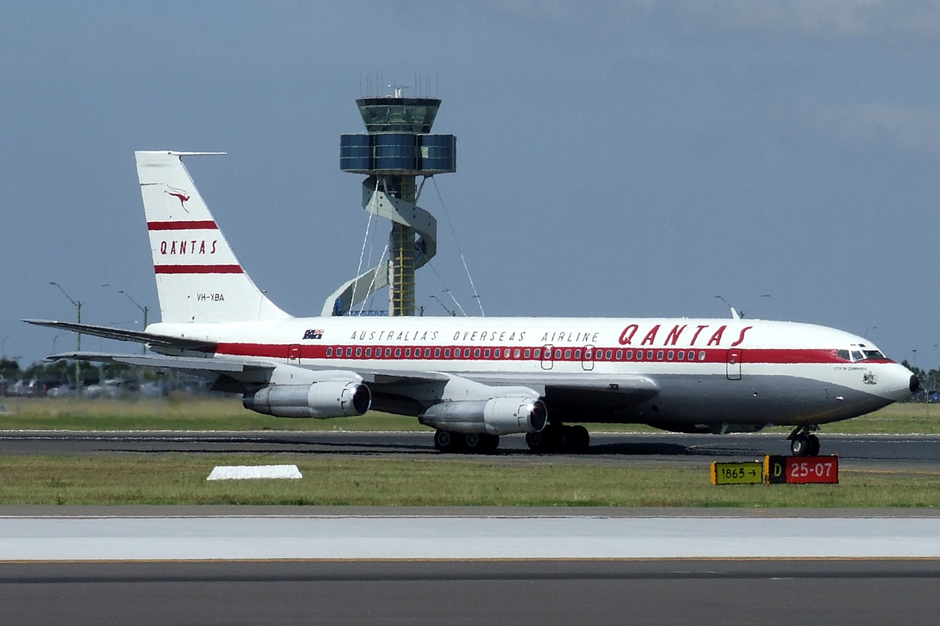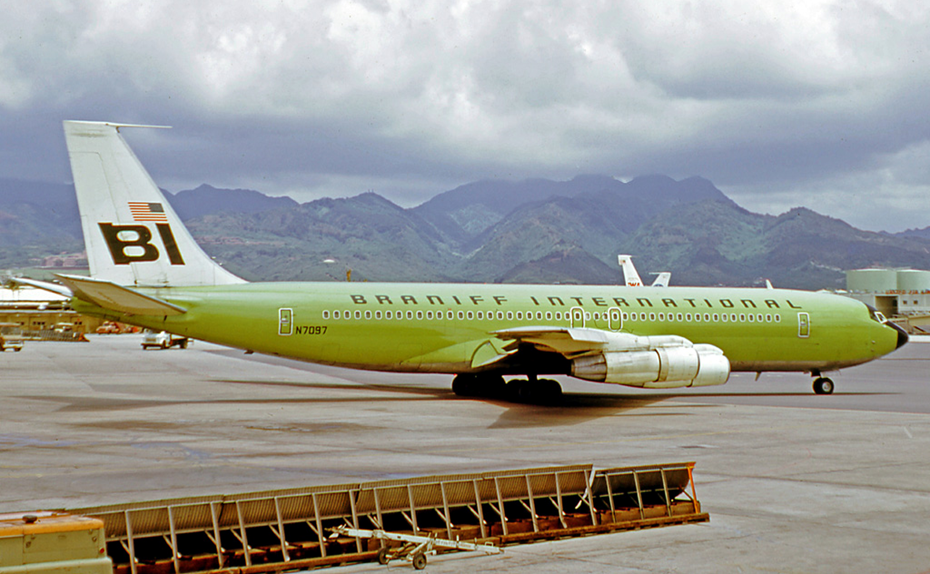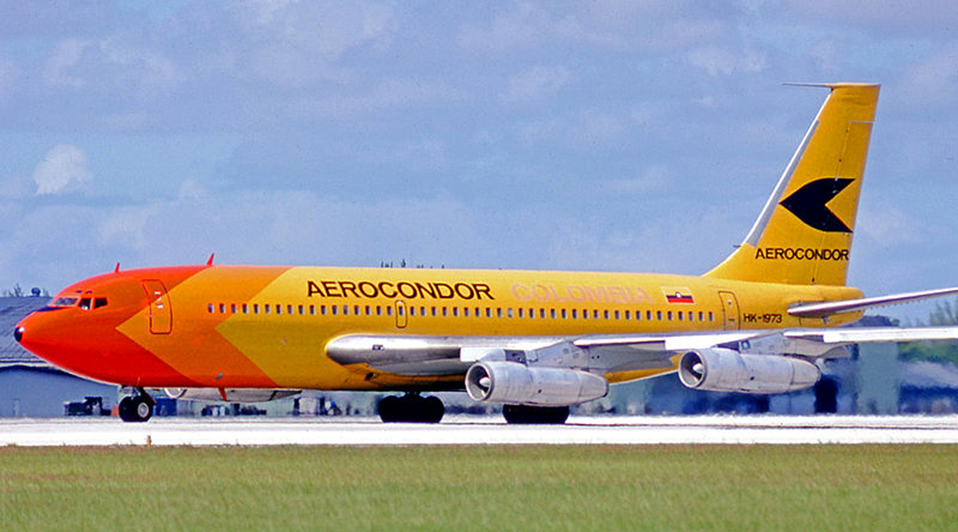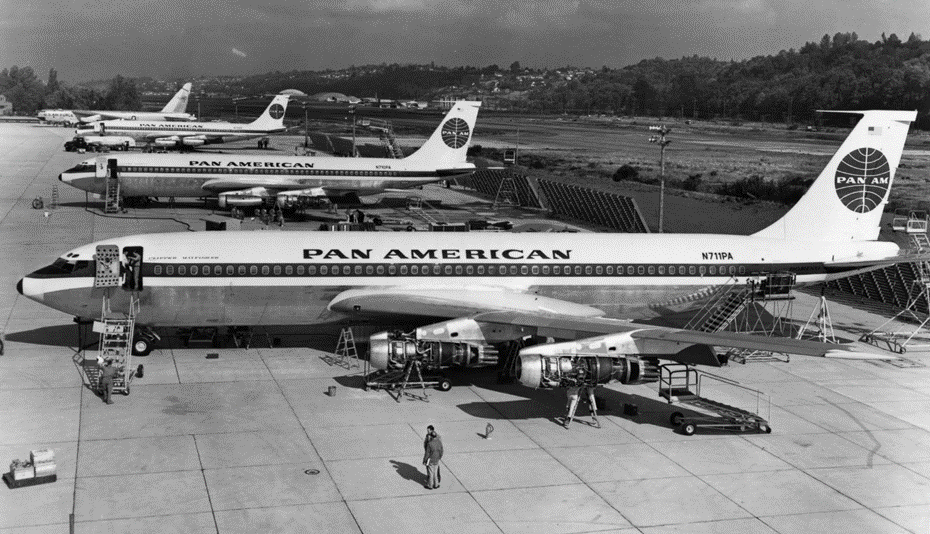



707…the start of a dynasty

The de Havilland Comet was the world’s first jet airliner. The de Havilland Comet 4 was also the world’s first jet airliner to carry fare-paying passengers across the Atlantic. But the de Havilland Comet was not the world’s first jet airliner to become a commercial success. That was the Boeing 707 with 856 being built against 114 Comets. This is the Boeing’s story.
With the Comet first flying in 1949, and with both the Sud Aviation Caravelle and the Tupolev Tu-104 taking to the air in 1955, the USA was being left behind in the jet airliner stakes. In fact Boeing’s last entry into the new airliner market had been the piston-powered Stratocruiser in1947. The company was, however, making jets. It had first flown the B-47 Stratojet, the first jet bomber for the USAF, at the end of 1947. This new military jet would keep Boeing busy until the production of 2,032 aeroplanes finished in 1956. To keep these new bombers constantly in the air, remember this was at the height of the cold war, they needed inflight refuelling, The USAF needed to replace their old B-29-based refuelling tankers with something more modern and Boeing offered them the KC-97 based on the piston engine Stratocruiser airliner.

811 of these new tankers would be delivered before production ceased in 1956, but by that time the B-47 replacement had also flown - the mighty Boeing B-52. It was abundantly clear that the USAF would need to replace their piston engine refuelling fleet with jet power. A pair of small jet engines had been added under the wings of the KC-97s to try and make them faster, to reduce the massive speed differential between the piston tanker and the jet bombers but this was far from ideal.

Boeing had begun studies into a new jet aeroplane to act as a tanker/freighter for the USAF, but there was still no great interest in a jet airliner from the US airlines. The tanker project produced the Boeing 367-80 known as the Dash 80 which first flew in 1954. The design team learned a lot about structures from the investigations of the Comet crashes, so the Dash 80 airframe was very strongly built. The following year the Dash 80 had been asked to fly over a major boat race in Seattle and Boeing had agreed. What they had not agreed however was for test pilot Tex Johnson to perform two barrel rolls with their new jet plane! Just like Roly Falk after rolling the Vulcan at Farnborough he was told not to do it again but it is generally conceded that many a delivery pilot also had a go at a barrel roll! Still officially known as the Dash 80, the new plane was unofficially known throughout the company as the Boeing 707.

To the uninitiated the new plane looks like the iconic Boeing 707. However it was always only going to be a proof of concept prototype and differed greatly from what was to become Boeing’s first jet airliner. The USAF liked what they saw and in 1955 placed an order for the production version that would be known as the C-135 in its transport role and the KC-135 as the tanker version. The first KC-135 tanker flew in 1956 and Boeing eventually built 803 of them. Today over 60 years later there are still about 550 in service.

By the mid to late 1950s US airlines were beginning to think more seriously about jets having seen European jet airliners entering service. Both Douglas and Boeing were developing aeroplanes, Douglas the DC-8 and a year or so ahead of them Boeing with their 367-80. There was however one big advantage for the airlines in ordering the DC-8, it was wider than the Boeing offering and could take six abreast seating whereas the Boeing could only manage five. American and United Airlines both pushed Boeing into making a wider fuselage for their new jet transport and when Pan American also joined the argument Boeing relented and took on a redesign of their proof of concept aeroplane. This new design was to be the start of the Boeing jetliner dynasty we know today and was now officially named the Boeing 707. With its fuselage wider and longer than the Dash 80 it could now claim to have the largest airliner cabin in the world. A claim Boeing used again in 1969 when the 747 Jumbo first flew. The first flight of this new transcontinental airliner took place in December 1957 with the first deliveries going to Pan Am and American Airlines in September 1958, one month before BOAC made the first Atlantic crossing by jet airliner carrying fare paying passengers with its Comet 4s.

Both the military C-135/KC-135 versions and the early Boeing 707s were powered by the Pratt and Whitney JT-3C Turbojet or the later more powerful JT-4A which were early generation engines - noisy, thirsty and not overly powerful. To overcome the lack of power they were fitted with water injection systems for use at take off. This produced the great plumes of black smoke so typical of airliners from the late fifties early sixties. When BOAC managed to convince the British Government they needed to order the Boeing to stay competitive on the trans-Atlantic route they specified Rolls Royce Conway engines be fitted. Not only was this a nod towards the ‘Buy British’ campaign but the Conway was also the world’s first production turbofan engine. What’s the difference between a turbojet and a turbofan? On a turbojet engine all the air entering the front of the engine travels through the core of the engine before rushing out of the jet pipe as thrust. On a turbofan there is an element of ‘bypass-air’ which means some of the air (a very small amount on the early turbofans) passes around the engine mixing at the jet pipe with the rest of the air that went through the core to produce the thrust.

This bypass air has a cooling effect on the air around the core, allowing the engine to operate at higher power settings without overheating. The bypass air contributes significantly to the engine’s total thrust and if the percentage of bypass air is great enough it acts as a sound barrier and the engine is quieter. Large modern turbofan engines such as the Rolls Royce Trent have taken this principle to the extreme but back when the Conway was designed fan blade technology was not as advanced as it is today and only 25 per cent of air was bypassed around the outside of the core engine compared with 80 per cent for the Trent. Pratt and Whitney responded to the Rolls Royce threat by adding a fan section to the front of their original JT-3C engine and re naming it the JT-3D. This would become the engine of choice to power most of the long range Boeing 707-320 Intercontinentals. A longer aircraft with a new wing now capable of flying the Atlantic non- stop.

Originally built with the JT-3C or JT-4D turbojets, these older aircraft could quite easily be re-engined with the new turbofan. In fact by the early 1980s when a large number of 707s were being scrapped, those with low time JT-3D turbofans were bought by the USAF and the engines used to re engined the USAF KC-135s that still had the old JT-3C turbojets fitted. With the Boeing now selling well around the world it became the symbol of the ‘Jet-set’ especially with Pan American. They operated two iconic flights PA001 and PA002 both circumnavigating the world but in opposite directions. The big white and blue Boeings could be found in all the world’s major cities and many exotic far-flung places. Juan Tripp the owner of Pan Am continued the tradition of naming Pan Am planes after sailing ships so all the 707s had a name beginning ‘Clipper’. With the cabin crew in elegant blue uniforms and the on-board first class lounge, the service on the new Boeing was akin to that of a luxury ocean liner.

The first of an endless list of operators outside the US was Australian airline Qantas who ordered 13 of a special variant of the original 707-100. This had an even shorter fuselage so reducing weight and making the aeroplane very powerful. This extra power was required for the popular Qantas route to Fiji which at the time had a short runway. When the runway was lengthened in the mid sixties Qantas traded in its hot rod specials for standard 707s and some of their earlier machines found their way to the UK operating with Laker and British Eagle. Others were sold to Braniff International airlines for flights to South America.

Another jet left Qantas for service in Canada and later as a VIP aircraft. Finally after use by the Saudi Government it ended up parked at Southend airport in 1999. This was in fact the first ever Boeing 707 delivered to Qantas and after restoration it left Southend in 2006 for the flight back to Australia and the Qantas museum at Longreach, Queensland. One of the other short body Qantas machines became the personal jet of actor John Travolta who in a deal with Qantas had it repainted in their original colours and he flew it around the world promoting the airline. Due to corrosion this aeroplane is now in store but the HARS museum in Australia are keen to add it to their collection of aircraft so it may fly again one day.

With the success of the long haul 707 under their belt Boeing had also been looking at a version for short haul routes. Thus they went back to the shorter original version of the 707 and carried out some major changes which reduced the weight considerably and this version became known as the Boeing 720. First flying at the tail end of 1959 production continued until 1962. 154 had been built when its place in the Boeing line up was taken by the new Boeing 727. Over this side of the Atlantic the 720 was operated by a number of airlines such as Lufthansa, Air Malta, Monarch, Conair, Middle East Airlines, Saudi Arabian and others. So happy were Boeing with the nose and fuselage design of the 707 they used it again on the Boeing 727 and Boeing 737, even today’s 737-MAX can trace the fuselage design directly back to the 707.

The mid 1960s were the zenith for production of the 707 with Boeing rolling two aeroplanes a week out of its factory at Renton, Seattle. However things were soon to change. In 1969 at the Boeing plant further up the road in Everett the Boeing 747 took to the air and the reign of the 707 as Queen of the skies ended. As airlines around the world started to take delivery of the new jumbo jet the 707 was pushed down on to lesser routes or sold on to secondary airlines. The early turbojet versions had very little value and were soon being scrapped along with any other high time airframes. Pan Am’s large fleet had eventually all gone by 1981, some to UK airlines such as Donaldson and British Midland.

Others were converted into freighters and flew on for some years to come, but unlike the DC-8s which were also being withdrawn and converted for cargo use the 707 design could not be stretched so its load capacity was not as good. Other ex-major airline aeroplanes found themselves working for a number of smaller airlines in South America or Africa. Some of these wore very colourful paint schemes.

Although the 747 Jumbo jet was now in full production Boeing kept the 707 line open to fulfil a steady trickle of orders for new aeroplanes, mainly cargo versions or one-off VIP aircraft for governments and the military including in 1972 a new Air Force One for the US President. This was not the first 707, or in military terms VC-37C, to fly the President around. The first had been delivered back in 1959 when President Eisenhower gave up his previous piston engine Constellation to join the jet age. Many other heads of state would end up using a new or revamped 707 for their personal transport.

A major fillip to the dwindling 707 production line came when the USAF ordered a new battle field surveillance platform based on the 707 to be known as the AWACS. First flying in 1975 this distinctive aircraft with a huge rotating scanner would be the final Boeing 707-based aircraft to be built at Renton when the production line finally closed in 1992. Ten years earlier Boeing had produced the last civil 707 which initially was retained by them as a sales demo aircraft trial fitted with the large CFM56 fan engines. However, with their own Boeing 757 coming into production the company did not push sales of the old airframe and the demonstrator was eventually re-engined back to the Pratt and Whitney JT-3D and sold to the Moroccan Government as a VIP aircraft, thus ending a production run of 856 civil airframes over a period of 28 years. The production line would finally close with another 84 AWACS and E-6 command post aircraft being built for the military, plus hundreds of C135/KC-135s based on the original Dash 80. A grand total of 1803 aeroplanes.

The Boeing 707 has been around for many years but we now consider it a rare aeroplane should one pass through our local airport. The last airline to use passenger configured 707s was SAHA of Iran, finally retiring the type from service in 2013. Boeing 707s still fly on in Iran but only with the military. Many smaller countries whose airlines once flew the mighty Boeing have also taken them on after airline retirement and converted them for use by their military or heads of state. For instance both Israel and South Africa took over airframes from the state airlines and converted them into intelligence gathering aircraft.

No new aircraft based on the C-135/KC-135 airframe had been built for many years, so where were the three planes ordered for the RAF to come from? Out of the storage yards in the desert three KC-135 tankers built back in the early 1960s were taken into a workshop and emerged a couple of years later as the RAF’s ‘new’ RC-135W and were delivered to RAF Waddington in 2013. At this time the airframes were already almost 50 years old. The extraordinary thing is the RAF intends to operate them until 2045 at which time they will be 80 years old! Who says Boeing don’t build aeroplanes to last!

What started out as a military aeroplane also ended production as such, but in the middle was an iconic jet airliner which became the stylish jet of the 1960s so let’s finish with a picture of where it all started: the 1958 production line ramp at Renton, Seattle and those early Pan American machines.
Don’t forget while we are being restricted by Covid-19 we will be posting two articles a month here on the website. Look out for the next one in two weeks time! There are also two posts a week on our Facebook page - The British Airliner Collection.

‘till the next time Keith
Registered Charity No. 285809